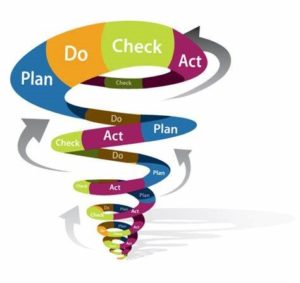Introduction
PDCA (Plan–Do–Check–Act) is an iterative four-phase analysis technique used to identify and support the continuous improvement of processes and products. PDCA helps businesses develop hypotheses about what needs to change, test, and implement in a constant feedback loop.
The successful use of PDCA achieves a balance between the systems and behavioral aspects of management. It also treats health and safety management as an essential part of best practices and governance generally, rather than as a stand-alone system.

Dr. William Edwards Deming developed the PDCA in the 1950s. Deming called it the “Shewhart Cycle,” as his model, based on the work of his mentor Walter Shewhart goal was to create a way of identifying what caused products to fail to meet customers’ expectations and objectives.
“There is nothing so useless as doing efficiently that which should not be done at all.”
PDCA Framework
The four (4) phase PDCA Framework includes the below components.
- Plan: Identify and analyze the problem or opportunity, develop hypotheses, and decide to change alternatives to test.
- Do: Test or prototype the potential solution, preferably on a small scale, and measure the outcomes.
- Check: Review the test, analyze the results, measure effectiveness, and decide whether the hypothesis is supported or not.
- Act: If the test is successful, incorporate what you learned into more extensive changes. Use what you learned to plan new improvements, beginning the cycle again. If the difference did not work, redo the sequence with a new plan.
PDCA Uses
The PDCA approach use supports:
- Set-up a project improvement project.
- Design (or redesign) a new or improved a process, product or service.
- Define a repetitive work process.
- Planning information collection and analysis to verify and prioritize problems or root causes.
- Implement change programs.
PDCA Phase Considerations
The PDCA use considerations encompass:
- Impact: What needs to be improved and why.
- Think about where you are now and where you need to be.
- What needs to be improved and why.
- Decide the priorities.
- Build and quantify a solid business case.
- Decide how you will measure performance; Identify appropriate success metrics. Think about ways to do this that go beyond looking at accident figures – look for leading as well as lagging indicators.
- Assess the risks, identify what could cause harm in the workplace, which could harm and how, and what you will do to manage the risk.
- Plan for changes and identify any specific legal requirements that apply.
- Responsible: PDCA Team Leader, Team Members & Stakeholders
- The Team Leader responsibility should be a commitment and not an arbitrary assignment. Individuals must have the accountability – don’t be vague by assigning a task to everyone.
- Identify Team Members and employee stakeholders, so that everyone is transparent on what is needed; develop positive attitudes and behaviors.
- Tasks & Resources: PDCA Activities and Resources
- Break down larger tasks for completion into smaller activities.
- Split larger goals into sub-goals so they can be able to be accomplished quicker.
- Decide on the preventive and protective measures needed and put them in place.
- Provide the right tools and equipment to do the job and keep them maintained.
- Train and instruct Team Members and employee stakeholders to ensure everyone is competent to carry out their work.
- Timeframe: Start, Milestone, and End Dates
- Avoid terms such as “ongoing” as they can often translate to “never-ending,” or just “never.”
- Agree on specific start, milestone, and end dates by PDCA executive sponsor and responsible Team Leader and not arbitrarily assigned.
Successful PDCA Outcomes
- Complete on time, on budget and to approved PDCA requirements and deliverables or,
- There is a recognition that the deadline is unable to meet the plan, and the PDCA Team Leader contacts and makes the responsible PDCA executive sponsor and other executive stakeholders aware of the situation. The outcome may result in an agreement of timeframes, or rescheduling of priorities and resources to still meet the original date.
Summary
Edwards Deming states, “It is not enough to do your best; you must know what to do and then do your best.” In large part, organizational deployment and operations are about managing change, whether intentional or unintentional.
Successful organizations apply PDCA on all levels and across the entire organization to make their infrastructure and resource capabilities more intelligent and agile in meeting market challenges and customer demands.
Knowledge Compass provides consulting services with the use of an array of Frameworks, Analyses Tools, and Interactions from their Best Practices Consultant Toolbox.


